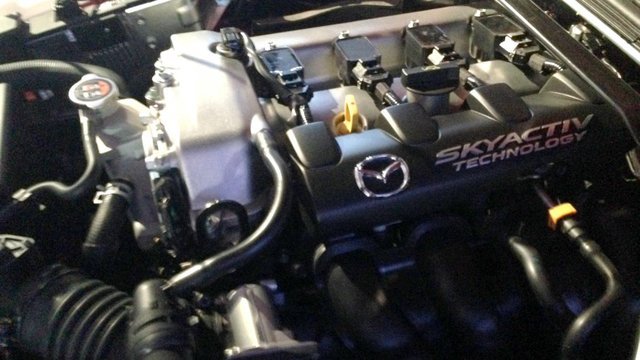2016 Mazda MX-5 Miata First Engine Shot Revealed

In the image above, the ND-generation Miata is clearly shown to be powered by a Skyactiv inline four-cylinder, as expected, but its displacement remains unclear. The engine is most likely either the 2.0-liter Skyactiv-G engine offered in low-end Mazda3 and CX-5 models or the 2.5-liter Skyactiv-G found in those same vehicles' upper trims. In those iterations, the 2.0-liter generates 155 horsepower and 154 pound-feet of torque, while the larger-displacement engine nets out at 184 hp and 185 lb-ft. There is no sign of a turbocharger, a feature rumored to be fitted to at least one test mule. There has also been previous rumors of a 1.5-liter Skyactiv engine, possibly for overseas markets.
The 2.0-liter strikes us as the most likely scenario, particularly as Mazda has worked diligently to save every gram in the new car, dropping a pledged 100 kilograms (220 pounds) over the current model, even while adding content. It's entirely possible that the alleged turbo car was, in fact, a mule for the Miata's Alfa Romeo sister car, which is expected to have a wholly different powertrain. Or it could simply be a second engine option for an eventual Mazdaspeed variant, perhaps.
Autoweek also notes that the battery is located in the very front of the engine compartment, as opposed to in the trunk like the NA and NB Miata. The new car's passenger compartment has been pushed back in the chassis and weight distribution near 50:50 has been pledged, so it likely wasn't necessary to put the battery in the back where it would eat up precious cargo space and require the added weight of longer leads. According to AW's report, packaging is extremely tight, with prominent coil-on-plug fixtures up top and a four-point strut tower brace vying for eyeball time.
The publication goes on to speculate that the MX-5 could have output figures lurking somewhere between Mazda's existing 2.0-liter and 2.5-liter engines, possibly with new heads and revised airflow. That makes sense to us, as we'd expect the ND to make a similar horsepower figure to the current car, if only to stave off criticism from spec-sheet bench racers.


